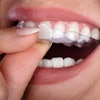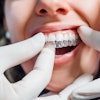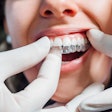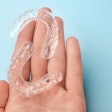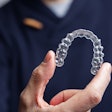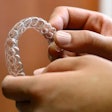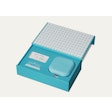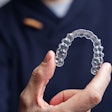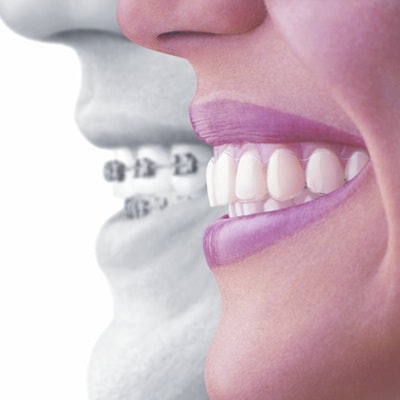
How does actual tooth movement with clear aligners compare with intended results? Are certain tooth movements easier to achieve than others? Researchers used 3D imaging software to examine the differences between predicted and achieved results.
They conducted a retrospective study of nearly 400 teeth in 20 adults patients treated with Invisalign aligners (Align Technology) who required further refinement after initial treatment. The results indicated that predicted and achieved horizontal tooth movements were similar, but vertical movements and intrusions of maxillary central incisors were less accurate.
"Rotations of canines and intrusions of incisors were the most inaccurate movements, suggesting that overcorrection of these movements could decrease the need for refinement," the authors wrote (American Journal of Orthodontics and Dentofacial Orthopedics, July 2018, Vol. 154:1, pp. 47-54).
The study was led by Orfeas Charalampakis, DDS, who was a student in the Master of Science in Dentistry program in the department of orthodontics at Saint Louis University in Missouri at the time of the study. Dr. Charalampakis now practices in Greece.
Aligner refinement
Few studies have examined the capabilities, biomechanics, and limitations of clear aligners, the authors noted. Some researchers have used objective criteria and concluded that clear-aligner treatment causes more relapse and is not very effective at controlling issues such as buccolingual inclination, occlusal contacts, occlusal relationships, overject, or overbite. These studies have also concluded that clear aligners are not as effective as fixed appliances for expansion.
“Rotations of canines and intrusions of incisors were the most inaccurate movements, suggesting that overcorrection of these movements could decrease the need for refinement.”
Other studies have used 3D superimposition of predicted and achieved models to measure the accuracy of tooth movements with clear aligners, but results have been unclear and were performed before the introduction of the newer aligner material (SmartTrack, Align Technologies). While this material is said to be more technologically advanced, further refinement treatment is often needed after initial treatment.
In the current study, the researchers used 3D models obtained with ClinCheck software (Align Technologies) to quantify the accuracy of specific tooth movements with Invisalign aligners and explore the reasons for refinement. They retrospectively studied the cases of 20 adults who required refinement with aligners after initial treatment.
The participants all underwent aligner treatment for both arches using SmartTrack material in 2014 or later in the orthodontics department at Saint Louis University or a private practice under the supervision of the same orthodontist. Inclusion criteria required that participants wore aligners consistently and that planned movement of molars was minimal in all three planes.
The patients had an average age of 37, and crowding ranged from mild to severe:
- Seven patients had mild crowding (0 to 3 mm).
- Eight patients had moderate crowding (3 to 6 mm).
- Three had severe crowing (greater than 6 mm).
Of the group, 13 had deep overbites, four a normal overbite, and three an anterior open bite. Two had minor spacing issues.
Aligner replacement occurred every two weeks, and average treatment time was 12 months. Intermolar width changed by an average of 0.81 mm, according to superimpositions of the initial and achieved models.
The researchers imported initial, predicted, and achieved digital models into image analysis open-source software. They used the starting point of the refinement to create the achieved models and superimposed each of the predicted and achieved models over the initial ones for posterior teeth.
The investigators measured vertical, horizontal, and rotational movements, as well as transverse widths, for 398 teeth, and they compared the amount of predicted and achieved tooth movement for each movement. They completed measurements of 50 predicted and 50 achieved movements for each study participant.
Horizontal movements appeared to be accurate, with differences between predicted and achieved amounts either small (0.20 mm to 0.25 mm) or insignificant, the researchers reported. They also found that extrusion of incisors appeared to be accurate, with no statistically significant differences observed. However, intrusion of incisors was the most inaccurate of linear movements, with the greatest difference of 1.5 mm (p < 0.002) recorded for maxillary central incisors.
The difference between predicted and achieved measurements was significant in the maxilla (p < 0.001) for horizontal movement of the canines but not in the mandible. The researchers also found that vertical canine movement was more predictable in the maxillary arch than in the mandibular arch.
Interpremolar expansion was accurate for both arches, as was vertical movement of mandibular first premolars. However, the findings for rotations were statistically significant for all teeth, with the greatest differences in the canines (maxillary arch 3.05°, mandibular arch 2.45°) and the least in the maxillary premolars (0.9°).
Numerous limitations
The authors cautioned that this research should be regarded as a pilot study due to several limitations, including the following:
- Small sample size
- Selection bias, due to being a retrospective study
- Heterogeneity of malocclusions
- Inclusion only of patients requiring refinement treatment, limiting the generalizability of the results
- Use of multiple teeth from each patient
The study results suggest that future research should focus on measuring fewer variables with a larger sample to obtain more reliable results, they added.
"No significant differences were detected between the predicted and achieved horizontal movements of teeth," they concluded. "However, the achieved rotations and vertical movements were significantly different than predicted."
